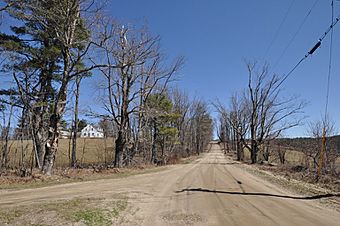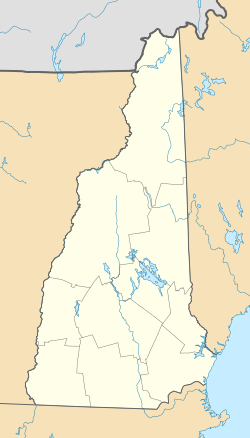Harrisville Rural District facts for kids
Quick facts for kids |
|
|
Harrisville Rural District
|
|

Mason Rd.
|
|
| Location | Roughly along Venable, Old Harrisville, New Harrisville, and Bonds Corner Rds., Harrisville, New Hampshire |
|---|---|
| Area | 1,510 acres (610 ha) |
| MPS | Harrisville MRA |
| NRHP reference No. | 86003078 |
| Added to NRHP | February 18, 1987 |
The Harrisville Rural District in Harrisville, New Hampshire is a special area listed on the National Register of Historic Places in 1987. This means it's an important historical place worth protecting. The district covers a large part of the town where Harrisville first started to grow. It includes old houses, farm buildings, and even hidden remains of very early settlements.
Contents
Exploring the Harrisville Rural District
This historic district stretches across the central southern part of Harrisville. Its western edge starts near Mason and Macveagh Roads. From there, it reaches eastward, including properties along Mason, Venable, and New Harrisville Roads. It goes all the way south to the town line with Dublin. Further east, you'll find properties on Bonds Corner Road, between Eastview and Lampman Roads. Some parts of Lampman Road are also included. A section of this district, along New Harrisville and Venable Roads, is also part of the Beech Hill Summer Home District.
A Glimpse into Harrisville's Past
Harrisville was first mapped out as part of Dublin in 1750. Surveyors divided the land into 220 lots. Sixteen of the very first settled lots are found within this district. This area had the best farmland in the entire town. Old property lines are still visible today. You can see them marked by roads (some still used, some abandoned), stone walls, and old trees.
From Farms to Factories
This area began as a place for families to grow their own food. But in the 1800s, it changed. It became a key supply center for the growing mill village in the heart of Harrisville. The farms here provided fresh food for the villagers and mill workers. They also raised sheep for wool, which the mills processed. Lumber from the district was used for building and making wood products.
Changes Over Time
In the early 1900s, farming and logging in the district slowed down. But the area found a new purpose. Wealthy families began building large summer homes here. These "country estates" helped the local economy. Today, the district helps us understand how Harrisville grew from a farming community to a busy mill town.



